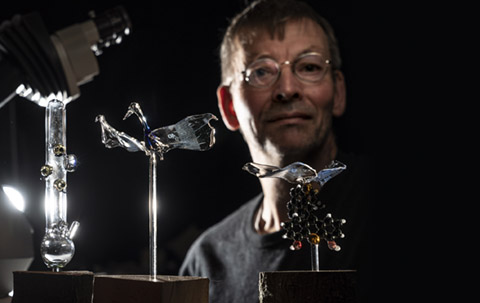
Marc Stuart turns lab waste into figurines
‘Science is also an art’
In the semi-darkness of one of Linnaeusborg’s laboratories, Marc Stuart is clearly in his element. Manoeuvring between the electron microscopes and desks lined with measuring equipment, he heads to the tray with drying petri dishes and beakers.
‘Glassware is normally reusable, unless it breaks. And I think I just spotted a broken one’, he says, carefully examining a 100 ml graduated cylinder. ‘Yes, somebody dropped it.’ With a happy smile: ‘Now I can turn this piece of glass waste into wings.’
The wings Stuart is talking about are a signature element of the figurines he makes from waste glass using a gas burner. To cut the wings out of the broken pieces of glass and mould them in the right way, he heats it up to as high as a thousand degrees. ‘Of course I’ve burned myself, but not too often, fortunately.’
Blue markings
Even though the figurines are usually transparent, Stuart always keeps the blue markings of the cylinders for the wings of his glass cranes and molecular groups. ‘This way, you can see where the glass came from. People who work in a lab recognise it immediately.’
People who work in a lab recognise it immediately
It turns out that people not only recognise the lab glass, but also really like his art. When a colleague shared a photo of one of the cranes on Twitter – ‘Nothing is a waste with a wizard like our EM facility manager Marc Stuart’ – it received over 4,400 likes and many retweets.
He definitely didn’t see that coming, he says. Somebody even commented that they also wanted a figurine. ‘Just send me your broken glass cylinder’, Stuart replied.
Lab glass is actually perfect for making art, he says, because it doesn’t break easily when heated or cooled. ‘But no one’s delivered any boxes with broken pieces so far’, he chuckles.
Memento
When Stuart picked up the glassmaking hobby of his youth again five years ago, he started out by making cranes in memory of the victims of the Malaysia Airlines flight MH17 crash. ‘It was my way of joining people who were folding a thousand origami cranes for each of the 298 victims as a symbol of peace and hope’, he says.
At first, it took him two hours to make one bird, but now he barely needs thirty minutes. Then, a colleague of his offered him pieces of broken beakers and out of curiosity, he tried to incorporate them in his figurines. ‘For me, glassmaking is also a learning process.’
When another colleague asked him to make a glass version of the sucrose molecule – because she works with sugars – he was happy to incorporate his hobby into his job.
‘Each atom usually takes me a minute, but I also use different colours for different molecules: oxygen is red, nitrogen is blue, hydrogens are white’, he explains. ‘Some molecules – like caffeine, which has all of them – can be very colourful.’
Molecular motor
One of his recent works is an artistic impression of molecular motors, for which Ben Feringa won a Nobel Prize. ‘But Ben hasn’t seen this one yet,’ he says, ‘because I still want to improve it.’
It’s good to reuse even tiny bits of materials like glassware
Perhaps his favourite piece is a tiny copy of an electron microscope made as a PhD defence present. ‘These yellow things are apertures’, he points out. ‘And this is the binocular used to look on a small screen that’s also in there.’
Stuart, who’s been with the UG for twenty-six years, is one of the pioneers in the field of cryo-electron microscopy for soft materials. ‘I help researchers visualise their soft nanomaterials in water or organic solvents’, he explains. Hardly anybody in the world does that. ‘So it’s really an exceptional playground.’
Waste
As the EM facility manager, he also participates in research of the entire faculty and has co-authored over 160 publications. In one of his latest contributions, for example, he visualised the process of creating new materials out of waste.
There’s a big drum of lab waste at FSE, too, he nods. ‘So it’s good to reuse even tiny bits of reusable materials like glassware, which often breaks in dishwashers.’
Small copper or gold grids can also be recycled. Stuart picks one up off the floor. ‘If I put this in the glass, it’ll form tiny droplets that’d look like stars.’
Creative
He never considered himself an artist, but Stuart believes that ‘science is also an art and every researcher should be creative’, he says.
‘That’s what I tell my PhD students: you have to be creative to do science because if you only follow what others did and never take risks, you will never take the next step.’
When there are no supervisors, do something crazy in the lab
One of the things that piques his own curiosity is how similar two seemingly opposite substances like molten glass and frozen water can be. ‘Rapidly frozen at a temperature below minus 180 degrees, water will be in a glassy state and will behave exactly the same as glass when you heat it up. It becomes flexible and you can do things on a small scale’, he enthuses.
He would like every student to spend more time doing ‘crazy experiments’, forgetting for a moment about the competition and the pressure to publish papers.
‘On Friday afternoons, when there are no supervisors, you can do whatever you like in the lab, so do something crazy’, he says. ‘If it doesn’t work, just stay quiet. But if it does work, then you have your breakthrough.’